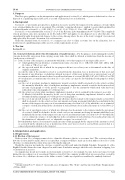Page 531 - SAIT Compendium 2016 Volume2
P. 531
IN 60 Income Tax acT: InTeRPReTaTIon noTes IN 60
1. Purpose
This Note gives guidance on the interpretation and application of section 11(o), which grants a deduction for a loss on disposal of a qualifying depreciable asset as a result of alienation, loss or destruction.
2. Background
Section 11 (o) previously provided for a deduction for assets used by the taxpayer for the purposes of trade which were scrapped during the year of assessment. The erstwhile ‘scrapping allowance’ applied to assets which quali ed for a deduction under sections 11 (e), 12D, 12F, 13 (1) or (4), 13 (8), 13bis (1), 13ter, 24G, and 27 (2) (b).
Section 11 (o) was substituted by section 27 (1) (f) of the Revenue Laws Amendment Act 45 of 2003. The completely revised provision came into operation on 22 December 2003 and applies to any disposal on or after that date. The amendment brought about material changes to the section. Among others, the use of the word ‘scrapped’ was removed and replaced by the words ‘alienation, loss or destruction’.
Under the amended form of section 11 (o) a taxpayer can elect to claim a revenue loss on the alienation, loss or destruction of a qualifying depreciable asset, if certain requirements are met.
3. The law
Section 11 (o)
11. General deductions allowed in determination of taxable income.—For the purpose of determining the taxable income derived by any person from carrying on any trade, there shall be allowed as deductions from the income of such person so derived—
(o) at the election of the taxpayer, an amount by which the cost to that taxpayer of any depreciable asset—
(i) which quali ed for an allowance or deduction in terms of section 11 (e), 11B, 11D, 12B, 12C, 12DA, 12E, 14, 14bis or 37B (2) (a); and
(ii) the expected useful life of which for tax purposes did not exceed ten years as determined on the date of original acquisition,
exceeds the sum of the amount received or accrued from the alienation, loss or destruction of that asset and the amount of any allowance or deduction allowed in respect of that asset in that year or any previous year of assessment or which was deemed to have been allowed in terms of section 12B (4B), 12C (4A), 12DA (4) or 37B (4) or taken into account in terms of section 11 (e) (ix), as the case may be: Provided that for the purposes of this paragraph—
(aa) the cost of any plant, machinery, implements, utensils or articles shall be deemed to be the actual cost plus the amount by which the value of such plant, machinery, implements, utensils or articles has been increased in terms of paragraph (v) of the proviso to paragraph (e) less the amount by which such value has been reduced in terms of paragraph (iv) of that proviso;
(bb) the actual cost of any plant, machinery, implement, utensil or article acquired by the taxpayer on or after 15 March 1984 shall be deemed to be the cost of that plant, machinery, implement, utensil or article as determined under paragraph (vii) of the proviso to paragraph (e);
(cc) the cost of any aircraft in respect of which any allowance has been made to the taxpayer under section 14bis shall be deemed to be the actual cost less any amount (not being an amount which has been included in the income of the taxpayer for any year of assessment in terms of section 8 (4) (i)) by which the cost or estimated cost price of such aircraft has in the calculation of such allowance been reduced in terms of section 14bis (2) (a);
(dd) the cost of any ship in respect of which any allowance has been made to the taxpayer under the provisions of section 14 shall be deemed to be the actual cost less any amount (not being an amount which has been included in the income of the taxpayer for any year of assessment in terms of section 8 (4) (d)) by which the cost or estimated cost price of such ship has in the calculation of such allowance been reduced in terms of the de nition of ‘adjustable cost’ or ‘adjustable cost price’ in section 14 (2):
Provided further that no election may be made in terms of this paragraph by the taxpayer if the amount received or accrued from the alienation, loss or destruction of the asset was received or accrued from a person that is a connected person in relation to the taxpayer;
4. Interpretation and application
4.1 Requirements
4.1.1 Election of the taxpayer
Under section 11(o) a taxpayer must elect to claim the allowance (that is, as a revenue loss). The section is silent on how the election must be made, but it is accepted that a taxpayer will have made an election under section 11(o) if the allowance is claimed in the return of income re ecting the disposal.
Should the taxpayer not make the election, a capital loss will result under the Eighth Schedule. Paragraph 11 of the Eighth Schedule de nes the term ‘disposal’ in wide terms. It includes amongst others the sale, donation, scrapping, loss or destruction of an asset.
A company may decide not to make an election under section 11(o), for example, because it does not expect to trade during the succeeding year of assessment. Under section 20(1) the company would forfeit any assessed loss created by the section 11(o) allowance because of the failure to trade,* while any capital loss would not be similarly forfeited.
* Interpretation Note 33 (Issue 2) ‘Assessed Losses: Companies: The ‘Trade’ and ‘Income from Trade’ Requirements’ (30 June 2010).
saIT comPendIum oF Tax LegIsLaTIon VoLume 2 523


